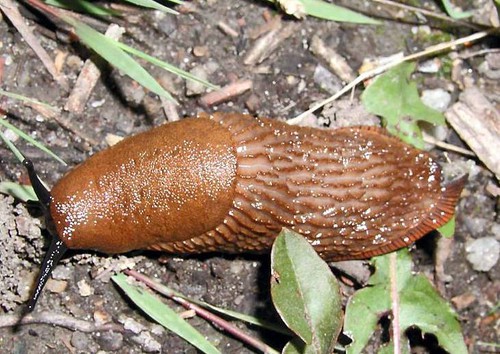http://en.wikipedia.org/wiki/Hagfish wrote:
<<Hagfish are marine craniates of the class Agnatha (Greek, "no jaws") or Myxini. Some researchers regard Myxini as not belonging to the subphylum Vertebrata. That is, they are the only living animals that have a skull but not a vertebral column. Recent molecular biology analyses tend to classify hagfish as invertebrates within subphylum Craniata, because of their short molecular evolutionary distance from Vertebrata (sensu stricto). The earliest fossil record dates back approximately 330 million years to the Late Carboniferous period. A single fossil of hagfish shows that there has been little evolutionary change in the last 300 million years.
Hagfish average about half a metre; The largest known species is Eptatretus goliath with a specimen recorded at 127 cm. Their unusual feeding habits and slime-producing capabilities have led members of the scientific and popular media to dub the hagfish as the most "disgusting" of all sea creatures. Hagfish can exude copious quantities of a slime or mucus of unusual composition. When captured and held e.g. by the tail, they secrete the microfibrous slime, which expands into a gelatinous and sticky goo when combined with water; if they remain captured, they can tie themselves in an overhand knot which works its way from the head to the tail of the animal, scraping off the slime as it goes and freeing them from their captor, as well as the slime. It has been conjectured that this singular behavior assists them in extricating themselves from the jaws of predatory fish or from the interior of their own "prey", and that the "sliming" might act as a distraction to predators. Recently, it has been proposed that the primary protective effect of the slime is related to impairment of the function of a predator fish's gills. Reportedly, most (all?) of the known predators of hagfish are birds or mammals, which could lend weight to the "gill-clogging hypothesis" as a highly successful evolutionary strategy tuned specifically to predatory fish.
An article published by the University of Queensland claimed the hagfish's eye, which lacks both lens and extrinsic musculature, as being significant to the evolution of more complex eyes. Hagfish eyespots when present can detect light, but as far as is known none can resolve detailed images. The digestive tract of the hagfish is unique among the vertebrates because the food in the gut is enclosed in a permeable membrane, analogous to the peritrophic matrix of insects.
Very little is known about hagfish reproduction. In some species, sex ratio has been reported to be as high as 100:1 in favor of females. Some hagfish species are thought to be hermaphroditic, having both an ovary and a testicle. Depending on species, females lay from one or two, to 20 to 30 tough, yolky eggs. These tend to aggregate due to having Velcro-like tufts at either end. Hagfish are sometimes seen curled around small clutches of eggs. It is not certain if this constitutes actual brooding behavior.
While polychaete marine worms on or near the sea floor are a major source of nutrition, hagfish can feed upon and often even enter and eviscerate the bodies of dead and dying/injured sea creatures much larger than themselves. They are known to devour their victims from the inside. In captivity, hagfish are observed to use the overhand-knot behavior "in reverse" (tail-to-head) to assist them in gaining mechanical advantage to pull out hunks of flesh from carrion fish or cetaceans, eventually making an opening to permit entry to the interior of the body cavity of larger carcasses. It is to be expected that a healthy larger sea creature would be able to outfight or outswim this sort of assault.
However, this energetic opportunism on the part of the hagfish can be a great nuisance to fishermen, as they can devour or spoil entire deep-drag netted catches before they can be pulled to the surface. Since hagfish are typically found in large clusters on and near the bottom, a single trawler's catch could contain several dozen or even hundreds of hagfish as bycatch, and all the other struggling, captive sealife makes easy prey for them.>>


